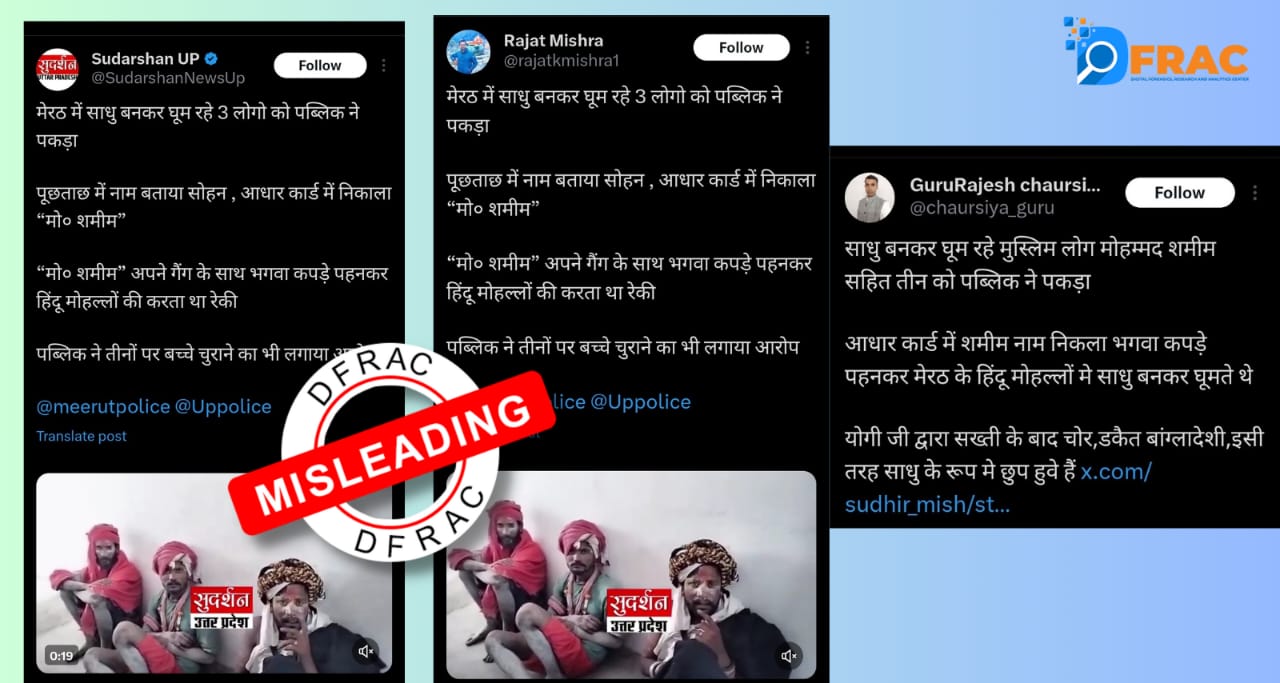An organised and worrying campaign of targeted propaganda against the Indian Army has come to light on Facebook. In which a large number of Bangladeshi Facebook users engage. These users are spreading propaganda like an organised gang to tarnish the image of the Indian Army on social media. As part of their propaganda campaign, these users have created fake accounts in the name of the armies. From the countries of India, China, Myanmar, and Nepal.
Through these accounts, individuals are sharing derogatory content about the Indian Army and military officials. Additionally, they are also serving provocative content on Kashmir, Manipur, and other sensitive issues. In this special report, DFRAC has exposed the organised campaign of such a group. It is doing targeted propaganda against the army and officials. This report analyses the patterns, accounts, and content that spread anti-India propaganda in a planned manner. The key points of this report are as follows-
1. Fake Facebook Accounts
1.1 Profiling of Fake Facebook Accounts
1.2 Deleted or Inactive Accounts
1.3 Facebook Account Creation and Frequent Renaming
1.4 Geographic Location
2. Networking and Sharing Patterns
2.1 Nexus of Fake Facebook Profiles
2.2 Eco-system of Account Promotion
2.3 Content Sharing for Algorithmic Boost
2.4 Copy-Paste Pattern of Content
2.5 Suspicious Role of Bangladeshi Users
3. Propaganda Content
3.1 Insult to Martyr Soldiers
3.2 Insult to Army Officers
3.3 Use of Derogatory Words for India and Army
3.4 Controversial Posts on Ladakh and Northeast
3.5 Use of False Maps for Propaganda
4. Theoretical Approach
4.1 Psychological Operations (PsyOps)
4.2 Perception Management
4.3 Information Operations – Information Operations (InfoOps)
5. Fake News and Fact Check
6. Conclusion
1. Fake Facebook Accounts
In this special report, the DFRAC team has exposed the activities of such networks. They are promoting anti-India narratives from across the border and using social media as a weapon of cyber war.
1.1 Profiling of Fake Facebook Accounts
The DFRAC team has identified a group of 7 fake Facebook accounts. They associate themselves with the armies of different countries or have associations with them. All these profiles feature pictures of the armies of those countries, or they use the national flag. They employ the armies and the national flag as a strategy to persuade users that their accounts are associated with that country. All these accounts continuously share anti-army propaganda and misleading information. Four of these accounts are still active. They are 1- China Military Force, 2- Myanmar Defense Force, 3- Chinese Army, and 4- Indian Defense Update.
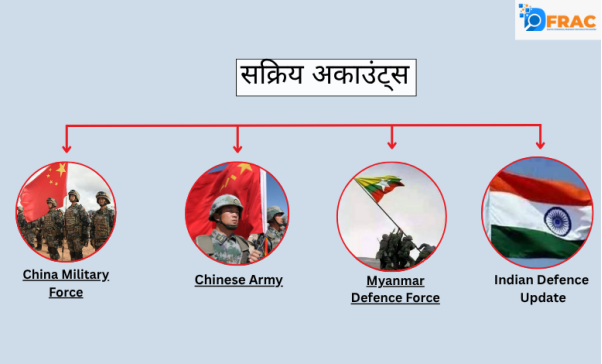
1.2 Deleted Accounts or Inactive Accounts
During its investigation, the DFRAC team found that there are three accounts of this group. They have either become inactive or deleted them. The first of these three accounts is the Arakan Army Force. The second is the Nepali Army Force, and the third is the Jummaland Army Force. We searched for these accounts on Facebook, but we could not find these three accounts. Here, we will tell you about these three deleted accounts that the Arakan Army Force actually named after Rakhine province of Myanmar. People call Rakhine Arakan. The Arakan Army also earns the title of the rebel army of Myanmar, which captured many cities in Rakhine.
According to a report by Deutsche Welle (DW), it serves as the military wing of the United League of Arakan (ULA), a political organisation of Buddhist people in western Rakhine state. In 2017, the Myanmar military launched a crackdown against Rohingya Muslims living in the state, forcing about 750,000 Rohingya to flee to several neighbouring countries, including India and Bangladesh.

On the other hand, “Jummaland” refers to the Chittagong Hill Tracts (CHT) in Bangladesh, a region inhabited by indigenous tribal groups collectively called the Jumma people. The word “Jumma” itself is derived from “jhum”, a type of shifting cultivation practiced by these tribes. The Jumma people, including various ethnic groups such as the Chakma, Marma and others, have distinct cultures, languages and religions, which often differ from the majority Bengali population. They have faced historical and ongoing challenges, including displacement, land grabbing and violence. The posts made by these Facebook accounts sarcastically allege that India and Myanmar have a strategy to separate Jummaland (Chittagong area) from Bangladesh. During the investigation of these accounts, we found many posts in which Arakan Army, Nepali Army and Jummaland Army were mentioned.
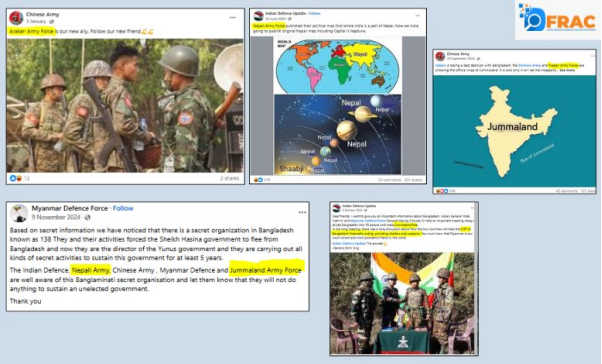
1.3 Facebook account creation and repeated name change
The Myanmar Defense Force created the first account of this group. We created this page on 28 March 2019. If we look at the activities of this phase, when we created this page, we named it Myanmar Defense Force, then we changed it to Myanmar Defense Army. On 16 January 2024, we again changed the name of this page to The Wolf of Bengal. After this, on 16 October 2024, we changed it again to Myanmar Defense Force, which is currently operating under this name.
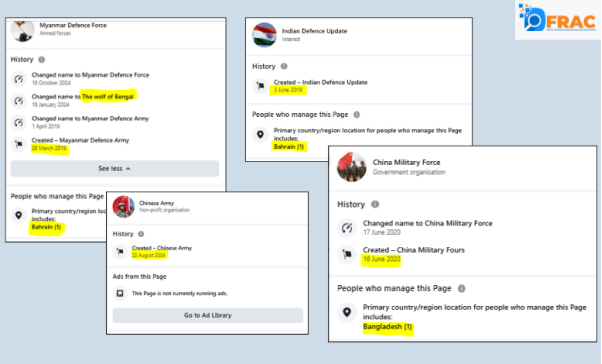
The second account of this group is Indian Defense Update. On 3 June 2019, the Facebook page was created. The third page of this group is the China Military Force. The creators established this account on 16 June 2020, then they named it China Military Fours; however, the very next day they changed it to China Military Force after they noted that the spelling of Force was written as Fours instead of Force. The group launched the fourth account, the Chinese Army, on 22 August 2024.
1.4 Geographical location of Facebook accounts
During the investigation of these accounts, we received information that neither Indian Defense Updates operates from India nor Myanmar Defense Army operates from Myanmar. On the transparency check of both these Facebook pages, we found that both these accounts operate from Bahrain. We found that the location of China Military Force is written as Fengtai, China, but when we checked the Facebook page transparency, we revealed that it operates from Bangladesh.

2. Networking and sharing pattern
During the investigation, we found that there was a strong networking and sharing pattern between these accounts. All the accounts were not only sharing content to reach each other’s posts, but were also trying to increase the reach through comments and likes.
2.1 Nexus of fake Facebook profiles
Accounts trying to show themselves as connected to the army or defense organizations like Indian Defense Update, Myanmar Defense Force, Chinese Army and China Military Force have common connections among themselves. On analyzing the activities, post pattern, and network connection of all these accounts, we can see that they deeply connect with each other. This network operates under a well-planned strategy aimed at creating confusion, propagating fake information and influencing public perceptions about the armed forces of India and neighbouring countries.
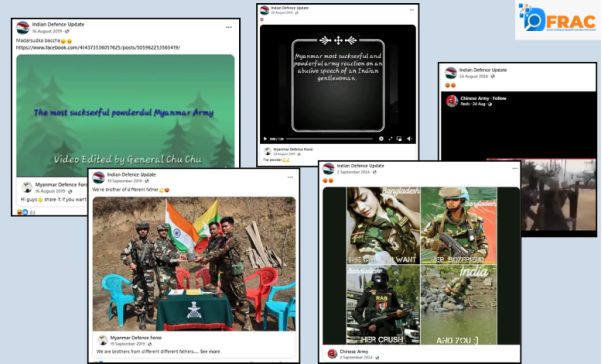
2.2 Ecosystem of account promotion
Indian Defence Updates, Myanmar Defence Force, Chinese Army and China Military Force operate actively on social media. They do not appear to be part of any individual efforts but operate under an organised and well-planned promotion ecosystem. The purpose of this ecosystem appears to be to increase the reach of these accounts and their content, spread propaganda narratives rapidly and influence social media algorithms. These fake accounts regularly like, comment and share each other’s posts, causing their content to go viral. This effort signals to the algorithm that the content is popular, which results in further increasing the visibility of the content.
In our investigation, we found many times that their strategy was successful and the reach of their posts reached millions. These fake accounts have created an echo chamber environment on Facebook, in which the platform repeatedly shows users the same type of content so that their thinking and perception gradually start molding in the direction that the propaganda network wants to promote. This ecosystem not only confuses the platform algorithm, but also has a deep impact on the thinking of the public.
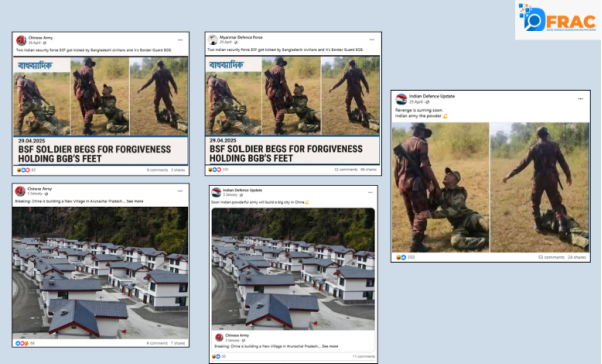
2.3 Content sharing for algorithm boost
The fake accounts Indian Defense Updates, Myanmar Defense Force, Chinese Army, and China Military Force exhibited a timely and coordinated pattern, as they posted and shared the same content multiple times within a few minutes. This created an impression of artificial popularity of the content being shared in the algorithm. These accounts shared propaganda content indiscriminately, so that their reach could reach as many people as possible in a few minutes.
The strategy of these accounts was that their propaganda content should match Facebook’s algorithm system and go viral. For example, we saw that the normal post of Indian Defense Update had very few likes and shares, but as soon as the entire group amplified this content, they liked and shared it heavily. The result was that the posts received a flood of likes and comments; some posts had 23 thousand likes and some had 24 thousand likes and people shared them more than 200 times.
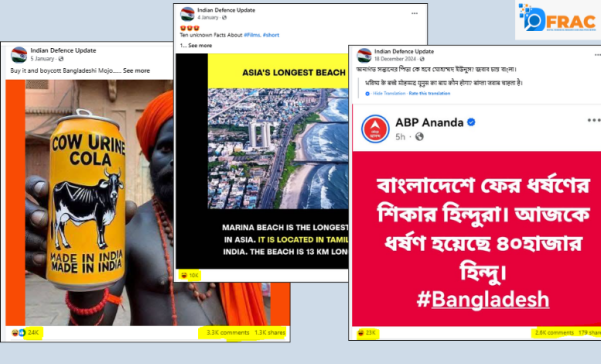
2.4 Copy-paste pattern of content
These fake Facebook accounts not only worked as an interconnected network, but their posts also demonstrated a copy-paste content pattern. We can consider this pattern as a part of the organized strategy of information warfare, because these accounts used fake identities of the army and shared derogatory, misleading and false news for propaganda. We found that the aim of such a copy-paste pattern of content was not only to post the content on all accounts but also to create an environment where users see the same kind of content everywhere and believe it to be true.
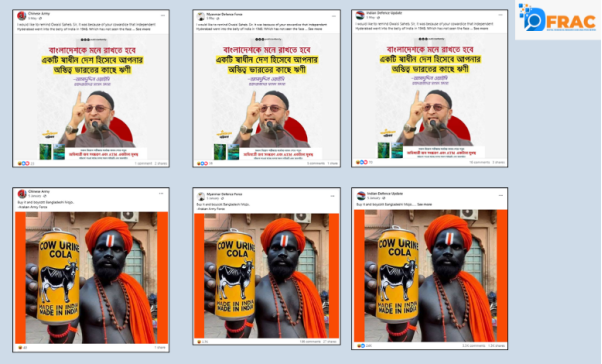

3. Propaganda Content
These accounts are full of propaganda content. This content insults the army, uses abusive and derogatory words, degrades the soldiers, and expresses malice against India. Here we are analyzing this type of content.
3.1 Insult to martyred soldiers
Indian Defense Update shared a post showing the bodies of many martyred soldiers of the Indian security forces. The photo had a caption written in English, which translates in Hindi as, ‘All our strong soldiers are sleeping right now because they worked hard last night and our honorable General Bichi Singh Sir said that sleep is the first thing to keep yourself away from any attack so that you become an explosive soldier.’ Most users gave laughing reactions to this post.

According to media reports, this photo depicts an ambush attack in Chintalnar in the year 2010, in which attackers killed 76 security forces personnel. Experts still consider this attack the deadliest Maoist attack in the country.
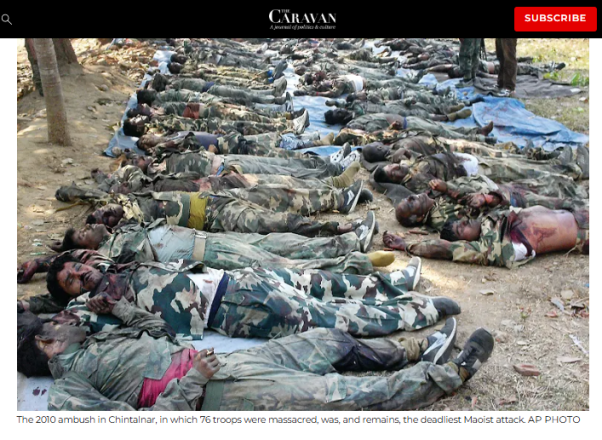
3.2 Insult to army officials
These accounts have posted insulting posts for senior officers of the Indian and Myanmar army. These accounts have used derogatory words for Indian Army Generals like General Bichi Singh Sir and General Boda Nath Sir and for Myanmar Army officers like General Chuchu Sir and General Maung Sir.

3.3 Use of derogatory words for India and Army
On analyzing the posts of these Facebook users, researchers found that these users have used derogatory words for India and the Indian Army in their posts. These users wrote these derogatory words in such a way that a sense of insult is expressed. For example, people use the slogan ‘Jai Hind’ to address everyone from common Indians to police and military forces, but these users replaced ‘Jai Hind’ with the word ‘Gay Hind’. These users have used phrases like Powderful Army to refer to the Indian Army in English instead of Powerful. These users have also used words like Sucksexfull instead of Successful.
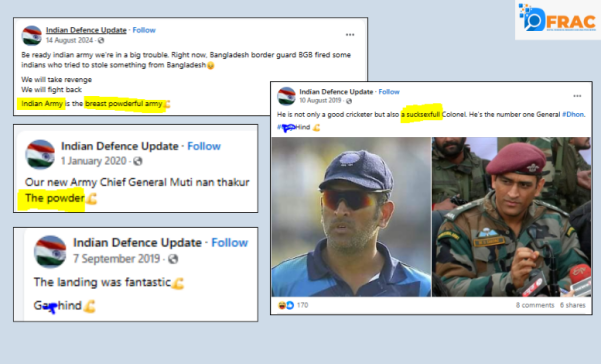
Apart from this, some individuals have used photographs in such a way that they have mocked and insulted the Indian Army. For example, in one photo, a soldier is showing a leg injury. People have shared this photo of the injured soldier to mock the Indian Army for standing with Israel.

3.4 Controversial posts on Ladakh and Northeast
The purpose of these accounts was not only to spread propaganda against the army and Indian institutions, but also to share controversial and misleading posts on sensitive and strategically important areas of India such as Ladakh and Northeast. These controversial posts also included raising doubts about India’s sovereignty and promoting foreign narratives. These users have especially posted controversial and misleading posts about the Manipur conflict, Arunachal Pradesh map dispute and Ladakh from the Facebook account of the Chinese Army.
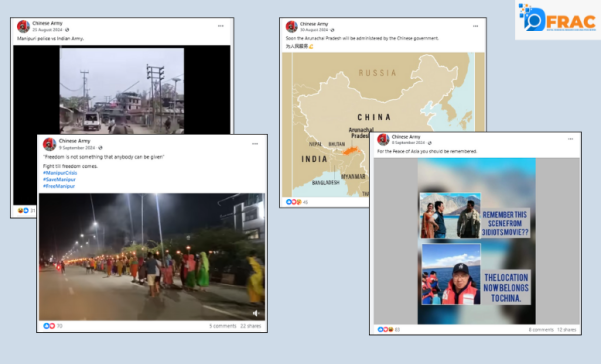
3.5 Use of wrong maps for propaganda
All these accounts have shared many controversial maps of Bangladesh. This controversial map shows some parts of West Bengal of India and many states of the Northeast as Bangladesh. These users have repeatedly posted many such maps, in which they show Indian states in Bangladesh. It is worth noting here that most of these posts made with the disputed map feature captions written in Bengali language.
4. Theoretical Approach
In the current digital age, nations do not only fight wars on borders, but in the borderless virtual world, entities always engage in an invisible war at the level of information, which can be called an information war. For this, they use information manipulation, fake news, misleading information, and propaganda. They carry out this war as a strategy to influence people’s thinking, perceptions, and attitudes, the scale of which is becoming like an industry in the present times.
Social media has become the biggest weapon in this information war. For example, we can take these fake Facebook accounts on social media, which someone named after the armies of India, Myanmar, and China, but someone operates them from Bangladesh and Bahrain. The report reveals that the suspicious Facebook accounts and their networks liare linkednk to the broader strategies of this information warfare. To understand these strategies, we need to focus on three key concepts-
4.1 Psychological Operations (PsyOps)
Psychological operations are considered to be the most effective strategy of information warfare. Its purpose is to influence the mindset, thinking and behavior of the public or the enemy in such a way that they start believing the predetermined narrative to be true. Anti-army messages posted by fake accounts on social media, insults to martyrs and use of misleading maps are part of this PsyOps. These operations are designed to create distrust, confusion and negative sentiments in the public so that the unity of society and the credibility of institutions can be harmed.
4.2 Perception Management
Perception management means controlling the perceptions and thoughts of people and molding them according to your goal. This strategy is very effective in information warfare because when the same type of content (such as anti-army posts, derogatory comments on martyrs) is repeatedly exposed to people, their perception starts getting affected. The suspicious accounts identified in this report have consistently tried to manage perceptions by presenting the military and institutions in a negative frame. The use of disputed maps, insulting martyrs and spreading misinformation have been done under this strategy.
4.3 Information Operations (InfoOps)
Information operations is a comprehensive strategy of information warfare that includes many techniques such as PsyOps, Perception Management, Disinformation, Cyber Operations and Social Media Manipulation. Its goal is not only to influence the thinking and perceptions of the enemy or target group, but also to undermine their information resources and establish its point of view. The suspicious Facebook network and its activities present an example of a classic information operation, where accounts together viralized anti-army narratives, promoted fake content and created an echo chamber in which people could hear and see only what the propaganda network wanted.
5. Fake news and fact check
These accounts have used fake and misleading information for propaganda. Here we are providing a fact check of the fake and misleading information spread by these fake Facebook accounts.
Fake/Misleading Information-1
Indian Defense Update claimed in a post made on May 8 that more than 50 Indian soldiers were killed in the border conflict with Pakistan. This user has made this post in such a way that it appears that this is an account operated by the Indian Army, because at the end it is written that we will take revenge soon. After fact checking, the DFRAC team found that the claim of 50 Indian soldiers being killed in the conflict with Pakistan is false. Because there is no such report in which 50 Indian soldiers have been said to have been killed.
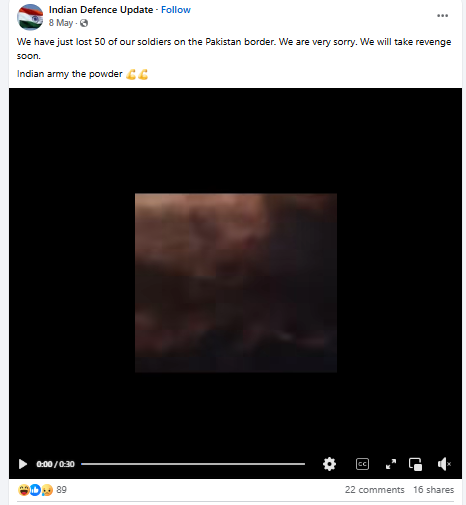
Fake/Misleading Information-2
Indian Defense Update has shared an infographic quoting CNN News. This infographic gives the figures of military losses suffered by India and Pakistan during the Indo-Pak conflict in May. According to this figure, India has suffered more military losses. The viral infographic is fake. No such infographic has been released by CNN. At the same time, no official figures of losses have been given by the armies of India and Pakistan.
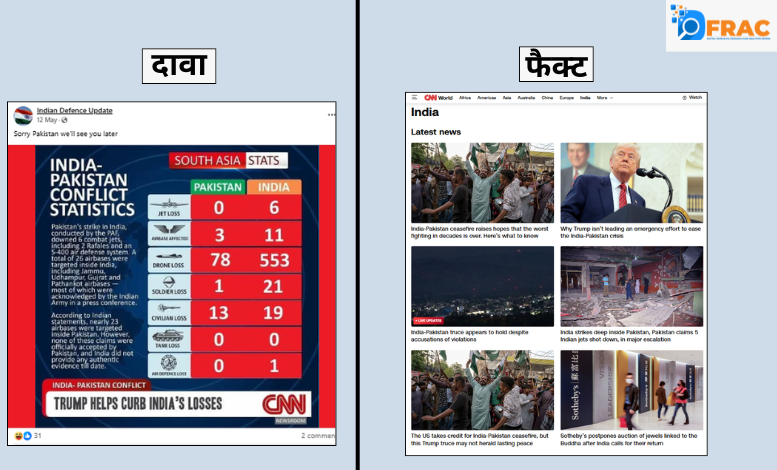
Fake/Misleading Information-3
A screenshot of a tweet by NDTV has been shared from the Facebook page of Indian Defense Update. The text in the screenshot says that New Delhi called an emergency meeting because BD (Bangladesh) has planned to attack the Seven Sisters (seven states of the Northeast). The headline is accompanied by the hashtag NDTVworld and a partial link to a report.
DFRAC’s investigation found that Indian Defense Update has shared a fake screenshot of NDTV. In the original screenshot, we see that after the policemen went on strike in Bangladesh, students managed the traffic.

Fake/Misleading Information-4
The Chinese Army shared a post claiming that China now occupies Pangong Tso Lake in Ladakh, where Aamir Khan’s film ‘Three Idiots’ was shot. The post states that keeping it is necessary for the peace of Asia. The DFRAC team found in its investigation that it went viral in the year 2020 with the same claim. But this video is of Chinese tourists from the Chinese side of Pangong Tso Lake. It is not of Pangong Tso Lake in Indian territory. Therefore, this claim is false.

6. Conclusion
Organised groups are operating the suspicious fake Facebook accounts active on social media. It includes Indian Defence Update, Myanmar Defence Force, Chinese Army, and China Military Force. These are not individual accounts, but whose activities indicate that they are waging an information war. Aimed at tarnishing the image of the Indian Army and national institutions. Also spreading propaganda against sensitive areas like Ladakh and the Northeast.
These accounts used strategies such as copy-paste content patterns, algorithm boosting content sharing, and an ecosystem of account promotion to spread propaganda content on a wide scale. Through disputed maps and anti-army posts, not only did someone attempt to spread confusion among the public, but also did someone attempt to question the territorial integrity of India. This entire network is acting as a nexus and spreading propaganda against India. Such networks with the identity of the army are proving to be a challenge on social media, from which there is a need to be cautious.



